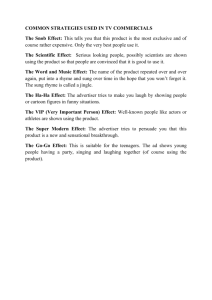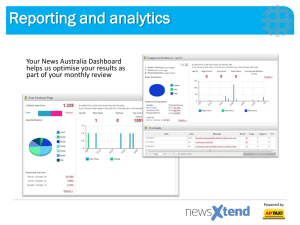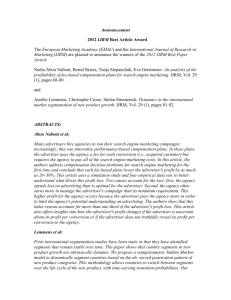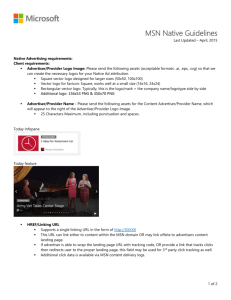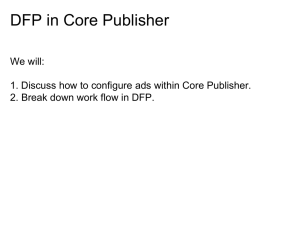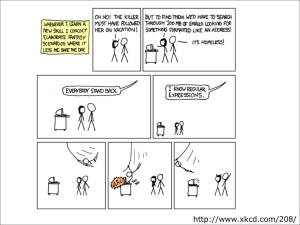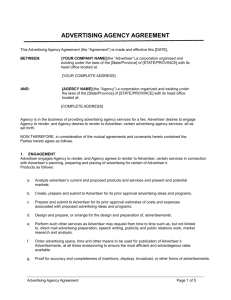RTB Glossary
advertisement
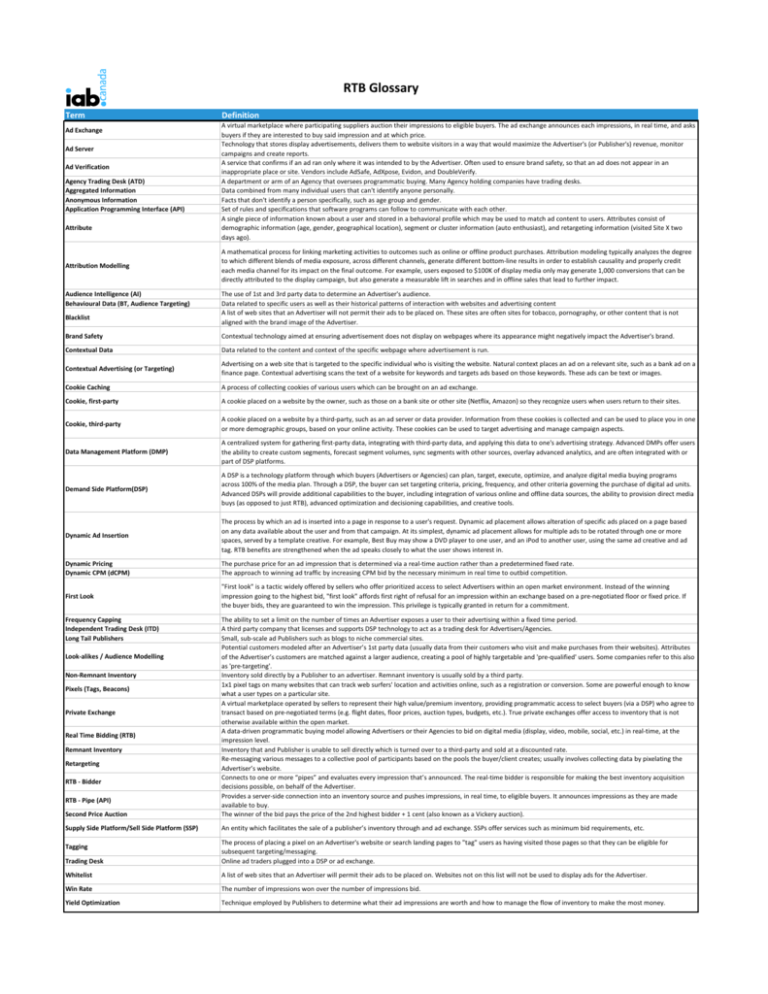
RTB Glossary Term Ad Exchange Ad Server Ad Verification Agency Trading Desk (ATD) Aggregated Information Anonymous Information Application Programming Interface (API) Attribute Attribution Modelling Audience Intelligence (AI) Behavioural Data (BT, Audience Targeting) Blacklist Definition A virtual marketplace where participating suppliers auction their impressions to eligible buyers. The ad exchange announces each impressions, in real time, and asks buyers if they are interested to buy said impression and at which price. Technology that stores display advertisements, delivers them to website visitors in a way that would maximize the Advertiser's (or Publisher's) revenue, monitor campaigns and create reports. A service that confirms if an ad ran only where it was intended to by the Advertiser. Often used to ensure brand safety, so that an ad does not appear in an inappropriate place or site. Vendors include AdSafe, AdXpose, Evidon, and DoubleVerify. A department or arm of an Agency that oversees programmatic buying. Many Agency holding companies have trading desks. Data combined from many individual users that can't identify anyone personally. Facts that don't identify a person specifically, such as age group and gender. Set of rules and specifications that software programs can follow to communicate with each other. A single piece of information known about a user and stored in a behavioral profile which may be used to match ad content to users. Attributes consist of demographic information (age, gender, geographical location), segment or cluster information (auto enthusiast), and retargeting information (visited Site X two days ago). A mathematical process for linking marketing activities to outcomes such as online or offline product purchases. Attribution modeling typically analyzes the degree to which different blends of media exposure, across different channels, generate different bottom-line results in order to establish causality and properly credit each media channel for its impact on the final outcome. For example, users exposed to $100K of display media only may generate 1,000 conversions that can be directly attributed to the display campaign, but also generate a measurable lift in searches and in offline sales that lead to further impact. The use of 1st and 3rd party data to determine an Advertiser's audience. Data related to specific users as well as their historical patterns of interaction with websites and advertising content A list of web sites that an Advertiser will not permit their ads to be placed on. These sites are often sites for tobacco, pornography, or other content that is not aligned with the brand image of the Advertiser. Brand Safety Contextual technology aimed at ensuring advertisement does not display on webpages where its appearance might negatively impact the Advertiser's brand. Contextual Data Data related to the content and context of the specific webpage where advertisement is run. Contextual Advertising (or Targeting) Advertising on a web site that is targeted to the specific individual who is visiting the website. Natural context places an ad on a relevant site, such as a bank ad on a finance page. Contextual advertising scans the text of a website for keywords and targets ads based on those keywords. These ads can be text or images. Cookie Caching A process of collecting cookies of various users which can be brought on an ad exchange. Cookie, first-party A cookie placed on a website by the owner, such as those on a bank site or other site (Netflix, Amazon) so they recognize users when users return to their sites. Cookie, third-party A cookie placed on a website by a third-party, such as an ad server or data provider. Information from these cookies is collected and can be used to place you in one or more demographic groups, based on your online activity. These cookies can be used to target advertising and manage campaign aspects. Data Management Platform (DMP) A centralized system for gathering first-party data, integrating with third-party data, and applying this data to one's advertising strategy. Advanced DMPs offer users the ability to create custom segments, forecast segment volumes, sync segments with other sources, overlay advanced analytics, and are often integrated with or part of DSP platforms. Demand Side Platform(DSP) A DSP is a technology platform through which buyers (Advertisers or Agencies) can plan, target, execute, optimize, and analyze digital media buying programs across 100% of the media plan. Through a DSP, the buyer can set targeting criteria, pricing, frequency, and other criteria governing the purchase of digital ad units. Advanced DSPs will provide additional capabilities to the buyer, including integration of various online and offline data sources, the ability to provision direct media buys (as opposed to just RTB), advanced optimization and decisioning capabilities, and creative tools. Dynamic Ad Insertion The process by which an ad is inserted into a page in response to a user's request. Dynamic ad placement allows alteration of specific ads placed on a page based on any data available about the user and from that campaign. At its simplest, dynamic ad placement allows for multiple ads to be rotated through one or more spaces, served by a template creative. For example, Best Buy may show a DVD player to one user, and an iPod to another user, using the same ad creative and ad tag. RTB benefits are strengthened when the ad speaks closely to what the user shows interest in. Dynamic Pricing Dynamic CPM (dCPM) The purchase price for an ad impression that is determined via a real-time auction rather than a predetermined fixed rate. The approach to winning ad traffic by increasing CPM bid by the necessary minimum in real time to outbid competition. First Look "First look" is a tactic widely offered by sellers who offer prioritized access to select Advertisers within an open market environment. Instead of the winning impression going to the highest bid, "first look" affords first right of refusal for an impression within an exchange based on a pre-negotiated floor or fixed price. If the buyer bids, they are guaranteed to win the impression. This privilege is typically granted in return for a commitment. Frequency Capping Independent Trading Desk (ITD) Long Tail Publishers Second Price Auction The ability to set a limit on the number of times an Advertiser exposes a user to their advertising within a fixed time period. A third party company that licenses and supports DSP technology to act as a trading desk for Advertisers/Agencies. Small, sub-scale ad Publishers such as blogs to niche commercial sites. Potential customers modeled after an Advertiser’s 1st party data (usually data from their customers who visit and make purchases from their websites). Attributes of the Advertiser’s customers are matched against a larger audience, creating a pool of highly targetable and 'pre-qualified' users. Some companies refer to this also as 'pre-targeting'. Inventory sold directly by a Publisher to an advertiser. Remnant inventory is usually sold by a third party. 1x1 pixel tags on many websites that can track web surfers' location and activities online, such as a registration or conversion. Some are powerful enough to know what a user types on a particular site. A virtual marketplace operated by sellers to represent their high value/premium inventory, providing programmatic access to select buyers (via a DSP) who agree to transact based on pre-negotiated terms (e.g. flight dates, floor prices, auction types, budgets, etc.). True private exchanges offer access to inventory that is not otherwise available within the open market. A data-driven programmatic buying model allowing Advertisers or their Agencies to bid on digital media (display, video, mobile, social, etc.) in real-time, at the impression level. Inventory that and Publisher is unable to sell directly which is turned over to a third-party and sold at a discounted rate. Re-messaging various messages to a collective pool of participants based on the pools the buyer/client creates; usually involves collecting data by pixelating the Advertiser’s website. Connects to one or more “pipes” and evaluates every impression that’s announced. The real-time bidder is responsible for making the best inventory acquisition decisions possible, on behalf of the Advertiser. Provides a server-side connection into an inventory source and pushes impressions, in real time, to eligible buyers. It announces impressions as they are made available to buy. The winner of the bid pays the price of the 2nd highest bidder + 1 cent (also known as a Vickery auction). Supply Side Platform/Sell Side Platform (SSP) An entity which facilitates the sale of a publisher’s inventory through and ad exchange. SSPs offer services such as minimum bid requirements, etc. Look-alikes / Audience Modelling Non-Remnant Inventory Pixels (Tags, Beacons) Private Exchange Real Time Bidding (RTB) Remnant Inventory Retargeting RTB - Bidder RTB - Pipe (API) Trading Desk The process of placing a pixel on an Advertiser's website or search landing pages to "tag" users as having visited those pages so that they can be eligible for subsequent targeting/messaging. Online ad traders plugged into a DSP or ad exchange. Whitelist A list of web sites that an Advertiser will permit their ads to be placed on. Websites not on this list will not be used to display ads for the Advertiser. Win Rate The number of impressions won over the number of impressions bid. Yield Optimization Technique employed by Publishers to determine what their ad impressions are worth and how to manage the flow of inventory to make the most money. Tagging
